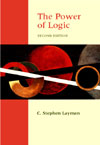|
 |  The Power of Logic, 2/e C. Stephen Layman
Table of Contents1. BASIC CONCEPTS
Validity and
Soundness
Forms and Counterexamples
Some "Famous" Forms
Strength and Cogency
2. IDENTIFYING ARGUMENTS
Arguments and Nonarguments
Well-Crafted Arguments
Notes
Appendix to Chapter
2: Argument Diagrams
3. LOGIC AND LANGUAGE /
Logic, Meaning, and Emotive Force
Definitions
Using Definitions to Evaluate Arguments
4. INFORMAL FALLACIES
Fallacies Involving Irrelevant Premises
Fallacies Involving Ambiguity
Fallacies Involving Unwarranted Assumptions
5. GATEGORICAL LOGIC: STATEMENTS
Standard Forms of Categorical Statements
The Traditional Square of Opposition
Further Immediate Inferences
6. GATEGORICAL LOGIC: SYLLOGISMS
Standard Mood, Form, and Figure
Venn Diagrams and Categorical Statements
Venn Diagrams and Categorical Syllogisms
The Modern Square of Opposition
Enthymemes
Sorites and Removing Term Complements
Rules for Evaluating Syllogisms
7. STATEMENT LOGIC: TRUTH TABLES
Symbolizing English Arguments
Truth Tables
Using Truth Tables to Evaluate Arguments
Abbreviated Truth Tables
Tautology, Contradiction, Contingency, and Logical
Equivalence
8. STATEMENT LOGIC: PROOFS
Implicational Rules of Inference
Five Equivalence Rules
Five More Equivalence Rules
Conditional Proof
Reductio ad Absurdum
Proving Theorems
9. PREDICATE LOGIC
Predicates and Quantifiers
Demonstrating Invalidity
Constructing Proofs
Quantifier Negation, RAA, and CP
The Logic of Relations: Symbolizations
The Logic of Relations: Proofs
Identity: Symbolizations
Identity: Proofs
10. INDUCTION
Inductive and Deductive Logic: Contrasts and
Clarifications (Statistical Syllogisms)
Arguments from Authority and Induction by Enumeration
Mill’s Methods and Scientific Reasoning
Arguments from Analogy
11. PROBABILITY
Three Theories of Probability
The Rules of Probability
Bayes’ Theorem
|
|
|



 2002 McGraw-Hill Higher Education
2002 McGraw-Hill Higher Education

 2002 McGraw-Hill Higher Education
2002 McGraw-Hill Higher Education